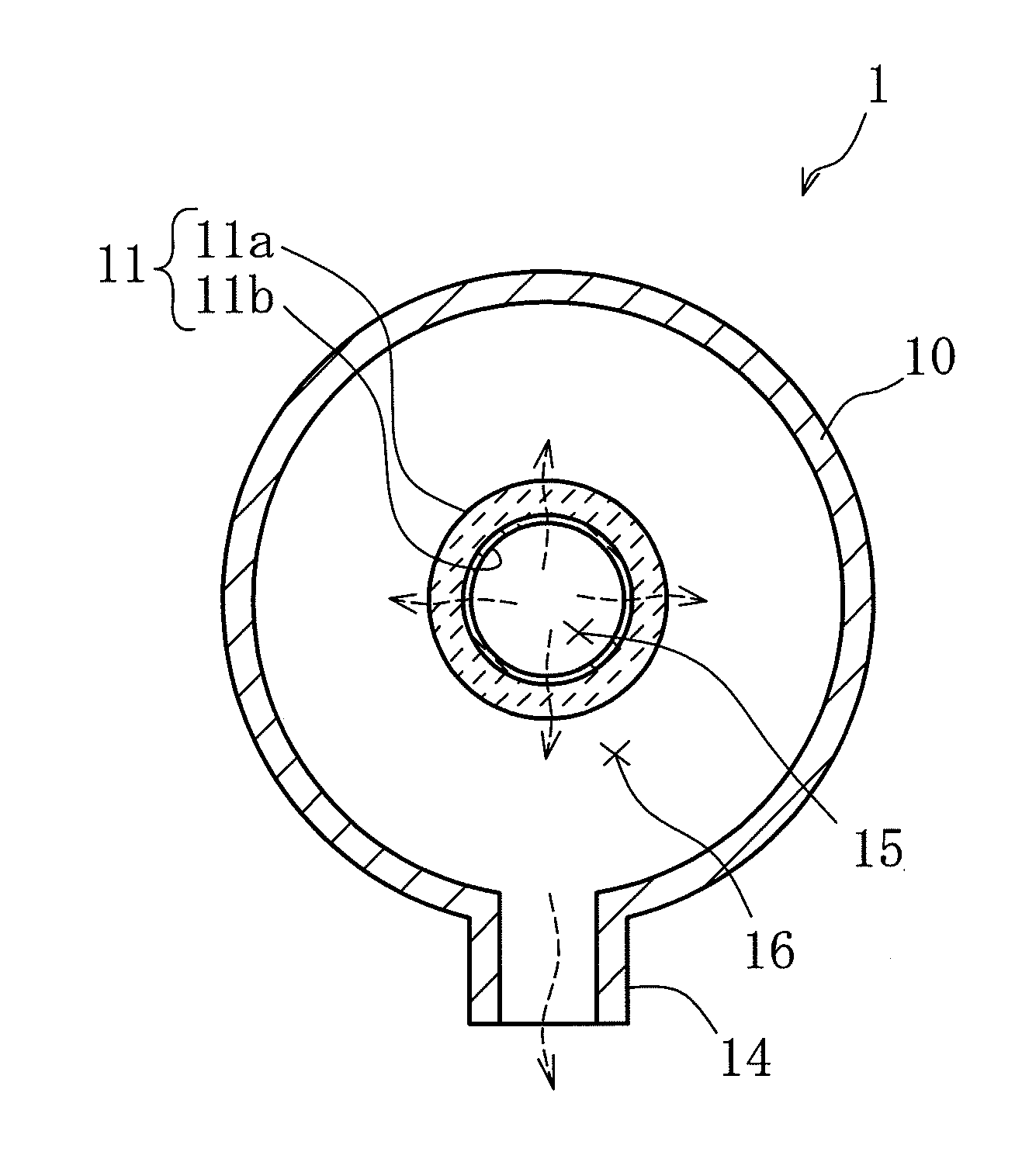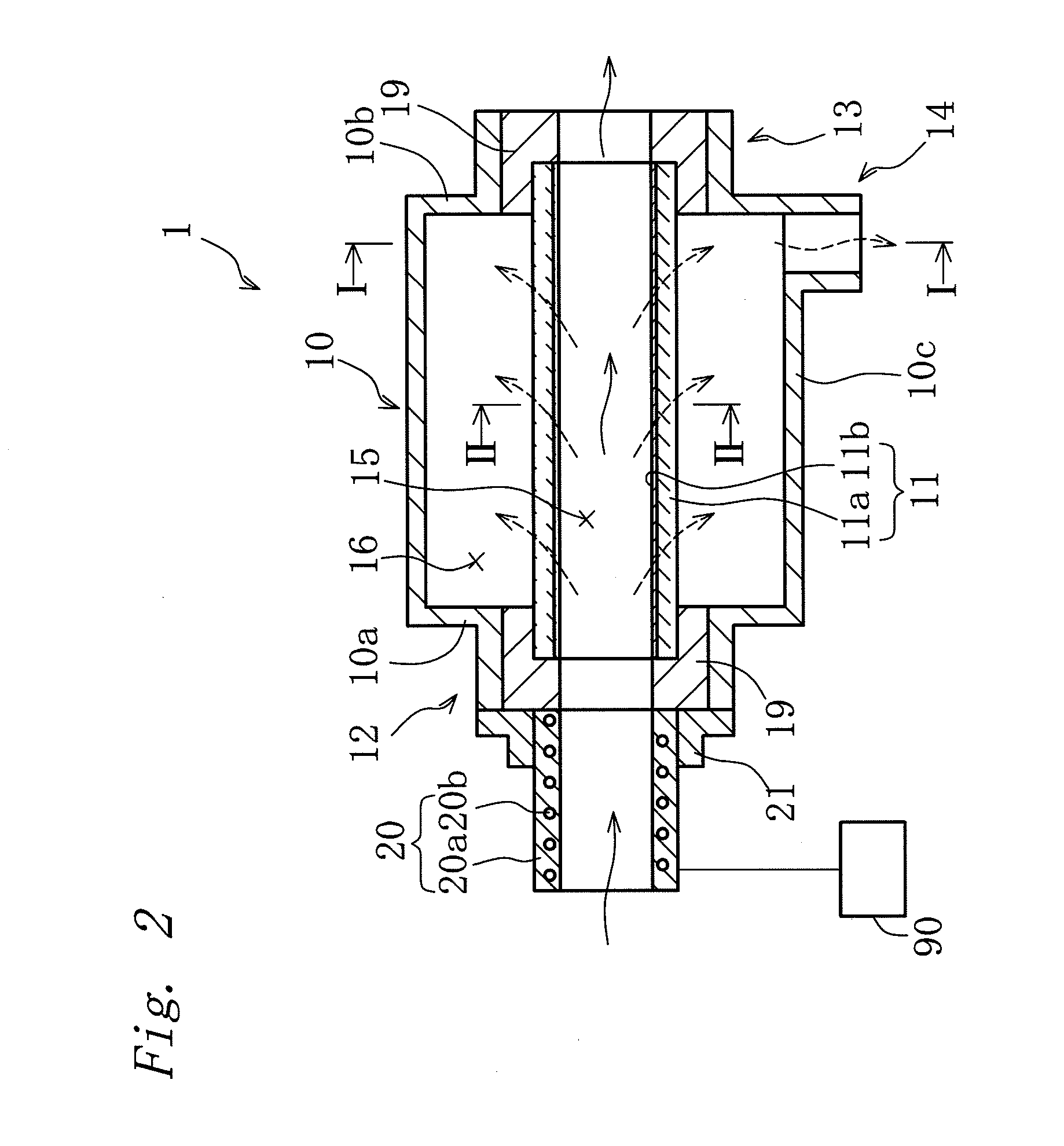Separator
- Summary
- Abstract
- Description
- Claims
- Application Information
AI Technical Summary
Benefits of technology
Problems solved by technology
Method used
Image
Examples
first embodiment
[0052](1) Structure of the Separator
[0053]A separator 1 according to the first embodiment is provided on a discharge side of a lubrication pump 3, as shown in FIG. 1. The lubrication pump 3 in a lubricating circuit of a wet sump engine 2 (hereinafter simply referred to an “engine”) pumps oil to respective parts of the engine 2.
[0054]The separator 1 is provided with a cylindrical separator main body 10 formed from metal, as shown in FIGS. 2 and 3. A ceramic filter 11 (provided as an example of a separation member of the present invention) is provided inside the separator main body 10. Both end portions of the ceramic filter 11 are attached to both end surface portions 10a and 10b of the separator main body 10 by way of ring members 19 having stepped holes. An inside of the separator main body 10 is partitioned by the ceramic filter 11, into a first area 15 inside the ceramic filter 11 and a second area 16 outside the ceramic filter 11. Further, an oil inlet 12 is provided to the firs...
second embodiment
[0063]A separator according to the second embodiment is explained below. In the separator according to the second embodiment, same reference numerals are provided to components substantially the same as the separator 1 of the above-described first embodiment, and detailed explanations of the components are omitted. Similar to the above-described first embodiment, a separator 1 according to the second embodiment is provided on a discharge side of a lubrication pump 3. The lubrication pump 3 pumps oil in a lubricating circuit of an engine 2 to respective parts of the engine 2.
[0064](1) Structure of the Separator
[0065]The separator 1 according to the second embodiment is provided, as shown in FIG. 5, with a cylindrical separator main body 10 having an oil inlet 32 feeding oil to inside and an oil outlet 33 discharging the oil. A cylindrical ceramic filter 31 is provided inside the separator main body 10. An inside of the separator main body 10 is partitioned by the ceramic filter 31, i...
third embodiment
[0075]A separator according to the third embodiment is explained below. In the separator according to the third embodiment, same reference numerals are provided to components substantially the same as the separator 1 of the above-described first embodiment, and detailed explanations of the components are omitted. Similar to the above-described first embodiment, a separator 1 according to the third embodiment is provided on a discharge side of a lubrication pump 3. The lubrication pump 3 pumps oil in a lubricating circuit of an engine 2 to respective parts of the engine 2.
[0076](1) Structure of the Separator
[0077]The separator 1 according to the third embodiment is provided with a ceramic filter 81. As shown in FIGS. 6 and 7, both end portions of the ceramic filter 81 are attached to an end surface portion 10a of a separator main body 10 by way of a lid member 22 and to an end surface portion 10b by way of a ring member 19 having a stepped hole. An inside of the separator main body 1...
PUM
| Property | Measurement | Unit |
|---|---|---|
| Temperature | aaaaa | aaaaa |
| Diameter | aaaaa | aaaaa |
| Shape | aaaaa | aaaaa |
Abstract
Description
Claims
Application Information
 Login to View More
Login to View More - R&D
- Intellectual Property
- Life Sciences
- Materials
- Tech Scout
- Unparalleled Data Quality
- Higher Quality Content
- 60% Fewer Hallucinations
Browse by: Latest US Patents, China's latest patents, Technical Efficacy Thesaurus, Application Domain, Technology Topic, Popular Technical Reports.
© 2025 PatSnap. All rights reserved.Legal|Privacy policy|Modern Slavery Act Transparency Statement|Sitemap|About US| Contact US: help@patsnap.com



